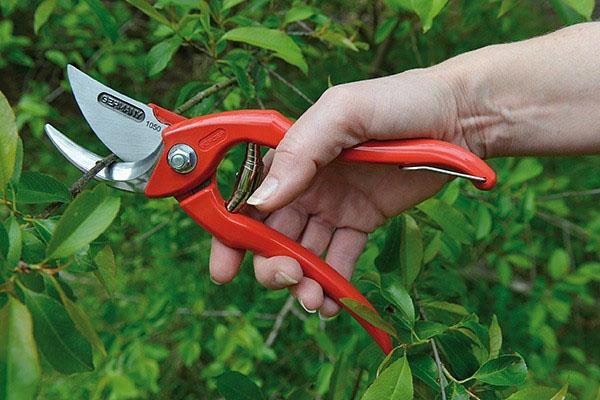Maintenance and correct use of the secateurs
 When pruning fruit trees and berry bushes amateur gardeners use a pruner. This garden tool is also used for grafting cuttings onto the stock and removing branches “on the ring”. With the help of a pruner with an extended handle, you can form the crown of mature trees.
When pruning fruit trees and berry bushes amateur gardeners use a pruner. This garden tool is also used for grafting cuttings onto the stock and removing branches “on the ring”. With the help of a pruner with an extended handle, you can form the crown of mature trees.
In order for the secateurs to serve for a long time, they need to be used correctly, and in order to avoid breakdowns, you need to know what parts the tool consists of and properly maintain it.
Accessories and pruning shears
The garden pruner consists of two parts: the cutting blade and the sickle part. Unlike scissors, the pruner has only one blade. Its crescent part is not sharpened and serves to clamp the branch.
The cutting part of the secateurs should always be closer to the tree. This will allow you to remove branches "on the ring" without leaving "stumps". If you need to graft a stalk onto a stock, then a sickle-shaped part should be placed closer to the tree. This will make the cut oblique and smooth.
The secateurs spring must be regularly tightened with a screwdriver. Before the autumn garden processing, the pruning shears spring is lubricated. Spring grease is supplied with branded secateurs.
There are plastic spring garden secateurs on sale. These tools are only suitable for pruning indoor green plants and young shrubs. Such pruners are not suitable for tree treatment.
Also supplied with some branded pruning shears:
- spare blades;
- whetstone or sandpaper;
- set of spare springs.
Once a year, the pruning shears' blades are sharpened. After tree trimming and shrubs, pruning shears must be properly stored.
Storing the secateurs
After use, the pruner must be cleaned of residual tree sap so that the blades do not rust during storage. If your garden tool does not have a built-in safety lock, purchase a detachable one for safe storage.
If the tool parts are made of soft metal without titanium sputtering, the pruning shears are stored in a dark place with low humidity. The same rule applies to spare blades and springs.
Before starting trimming, you need to prepare the tool for work: sharpen the blade, tighten and lubricate the tool spring. The sickle-shaped part of the secateurs is "skinned" with sandpaper, removing all the irregularities.